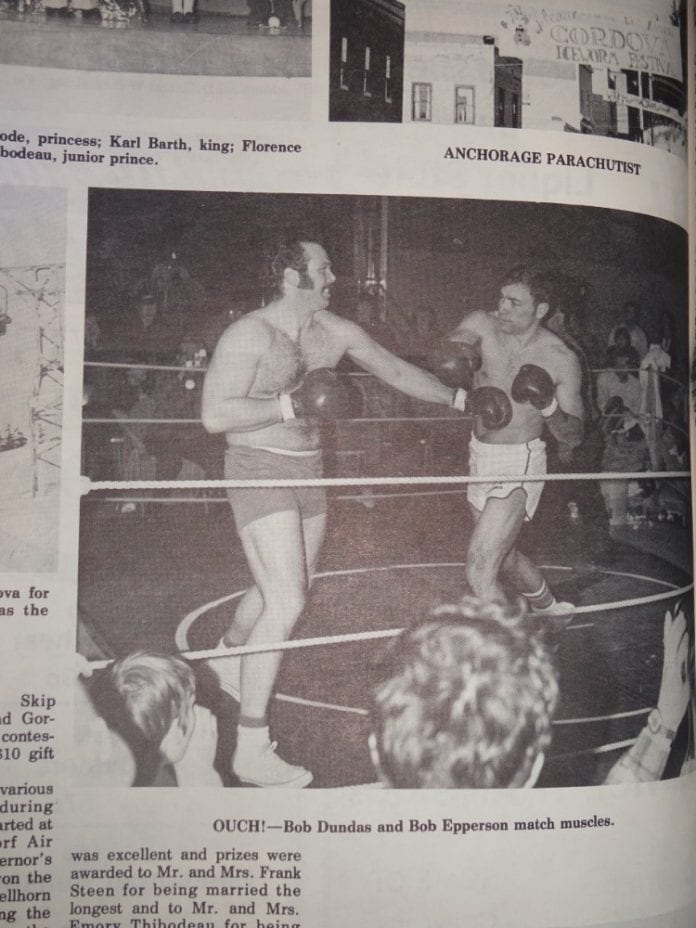
Cordova’s recently completed Fourth of July celebration was a big success. The Kelp Box races, revived through the efforts of Kelly Weaverling and many others, drew big crowds and delighted the throng. The gold-sprayed rubber cannery-worker glove trophies were a special touch, with the first place one-fingered model raised high in the air by winner Sheridan Joyce as the crowd cheered.
Not surprisingly, the biggest oohs and ahs came when entrants veered off course, one careening into bystanders near the finish line in front of Wells Fargo bank.
A few years ago, a kelp box special with steering and braking problems plowed into pedestrians on the hill headed down toward the harbor, resulting in an ambulance call. This year, that off-course route was blocked by orange plastic netting; and Police Chief Mike Hicks, who was standing nearby helping judge the races, appeared ready to tackle and ticket anyone who went astray.
The finish line was located exactly where 4th of July celebrations have been centered throughout Cordova’s history. A series of photos recently received from Justin Strom Jr., whose father was superintendent at a local cannery for years, display a big bandstand beside the awning of the old Lathrop Building, which was gutted by a major fire back in 1951. The cement walls of the structure remained intact, and were incorporated into the rebuilding of the bank on that site.
Floats and costumes were a big part of the 4th of July parades, and everyone gathered by the bandstand to receive prizes.
One of the major events of former 4ths that drew oohs and ahs from Cordovans was the boxing matches held at City Hall, now the Bidarka Rec center gym. A bonafide ring was set up in the middle of the court, with corner posts anchored by countless 50-pound bags of salt from canneries hauled up the stairs to the gym. One of Strom’s 4th of July photos shows young pugilists on a float displaying their prowess while advertising the bouts.

The matches began with the youngest lads going at it, and being showered with coins tossed onto the mat following each round. Gloves so large tykes could barely lift them were used in the lower matches.
There were some truly memorable matches in the higher divisions. Tatitlek had quite a boxing tradition, and would bring in several fine lightweights to square off against Cordova talent, that included Teddy Siemion and Dennis Lary. Cannery workers from Seattle and particularly those from the Philippines were lightning quick, and put on high quality displays of skill.
One bout in the higher weights that still sticks in my mind was a matchup between David Glasen Sr. and a dark horse opponent from the New England cannery. Back then there was no road to what is now Orca Adventure Lodge, and locals were abuzz about this boxer who trained in secret by tossing 50 pound boxes of canned salmon about like toothpicks. As I recall, the King of the Salmon Boxes was not as cagey as the solidly-built Glasen, who trained by making cement blocks for his father, Dar, and came through for the pro-Cordova fans.

The boxing tradition gradually faded, although legendary CHS basketball coach and then High School Principal Chuck Taylor would occasionally conduct bouts on the high school stage after school, back in the late 60s. With the curtains closed, and no audience on hand, lads who had issues during the day would work them out after school, wearing very large boxing gloves.
CHS was also the site of one of Cordova’s most memorable heavy weight bouts.
During the 1974 Iceworm Festival, Bob Epperson, CHS basketball coach, and Bob Dundas, local fisherman, battled for three rounds in a ring set up at midcourt. Both scored significant blows, and could barely lift their gloves by the last bell, in a match that was declared a draw.
Once known as “The Gentleman’s Sport”, boxing has faded in popularity and is no longer a Cordova 4th of July or Iceworm tradition.
However, boxing, and now kelp boxes, have been and will always be a big part of our rich Independence Day history.
Want more Cordova Chronicles? Click here to view the archives.














